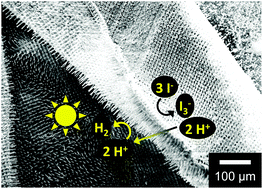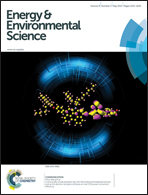Unassisted solar-driven photoelectrosynthetic HI splitting using membrane-embedded Si microwire arrays†
Abstract
Free-standing, membrane-embedded, Si microwire arrays have been used to affect the solar-driven, unassisted splitting of HI into H2 and I3−. The Si microwire arrays were grown by a chemical-vapor-deposition vapor–liquid–solid growth process using Cu growth catalysts, with a radial n+p junction then formed on each microwire. A Nafion proton-exchange membrane was introduced between the microwires and Pt electrocatalysts were then photoelectrochemically deposited on the microwires. The composite Si/Pt–Nafion membrane was mechanically removed from the growth substrate, and Pt electrocatalysts were then also deposited on the back side of the structure. The resulting membrane-bound Si microwire arrays spontaneously split concentrated HI into H2(g) and I3− under 1 Sun of simulated solar illumination. The reaction products (i.e. H2 and I3−) were confirmed by mass spectrometry and ultraviolet–visible electronic absorption spectroscopy.


 Please wait while we load your content...
Please wait while we load your content...